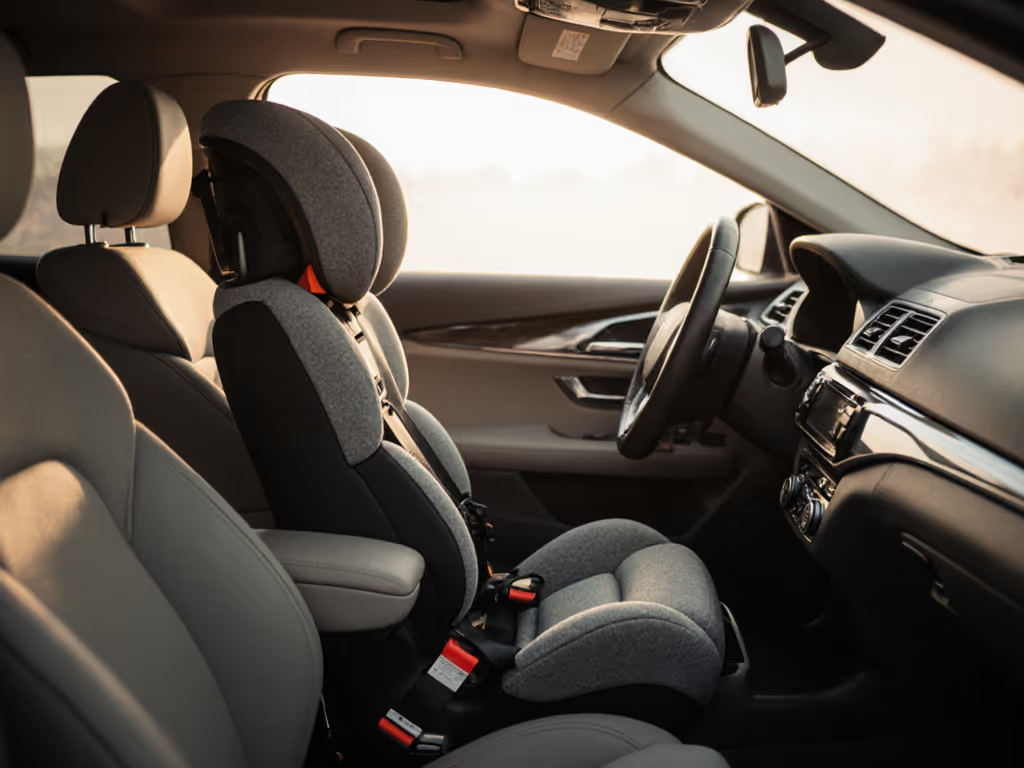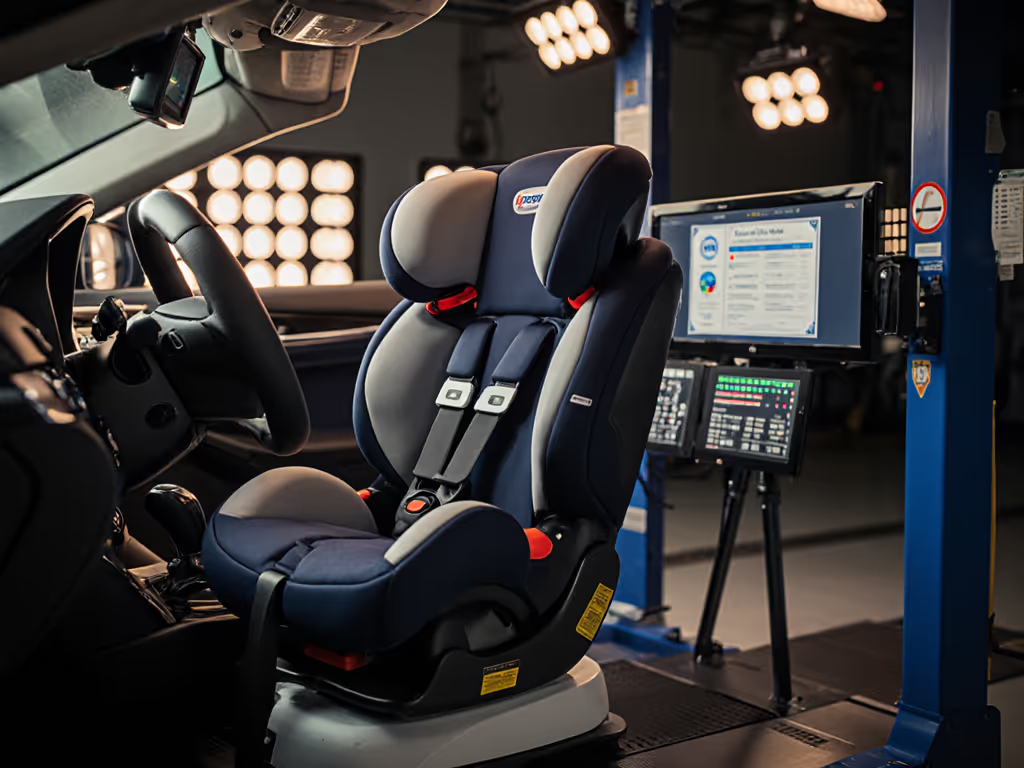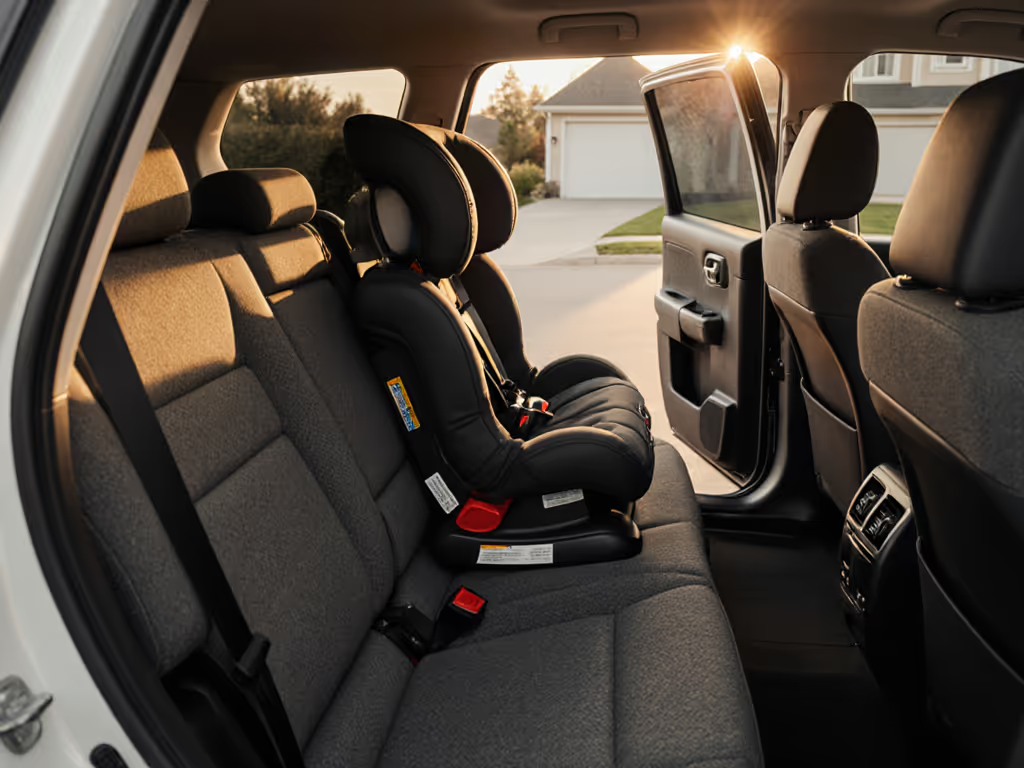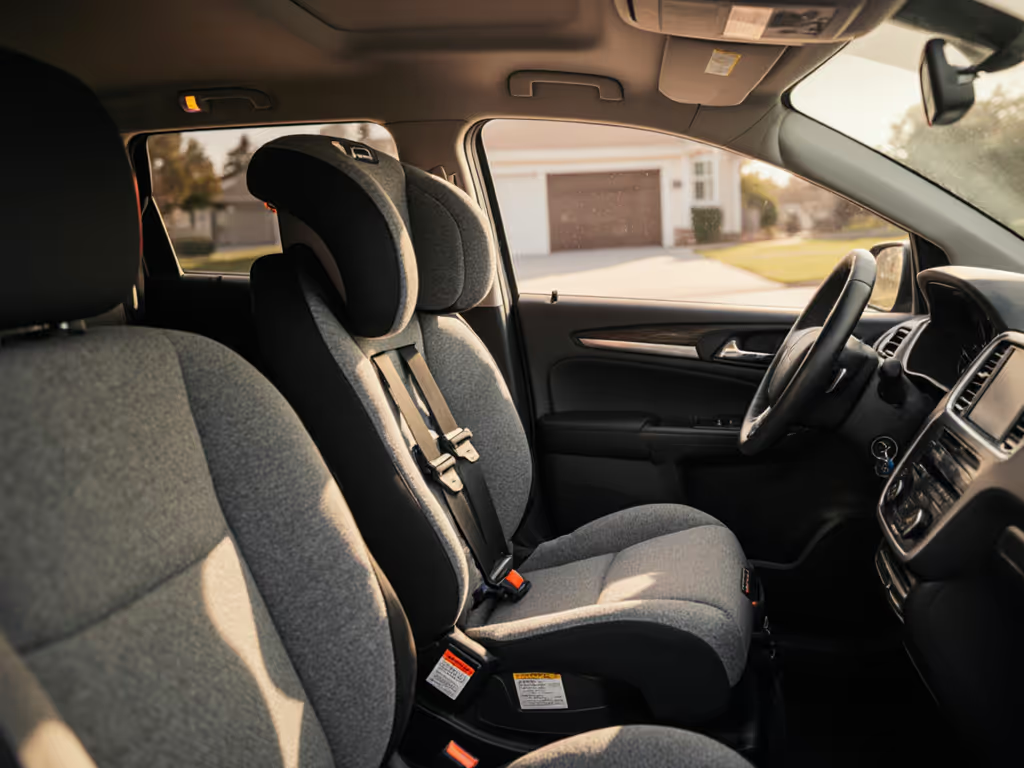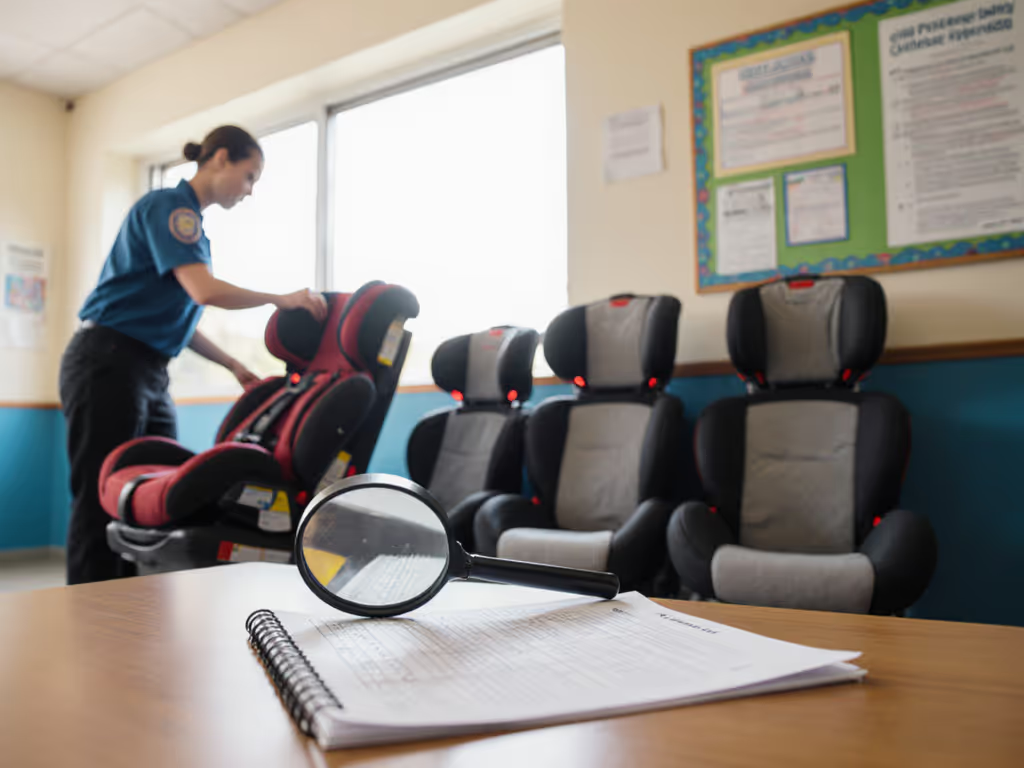
Why Use Convertible Seats: Complete Parent Guide
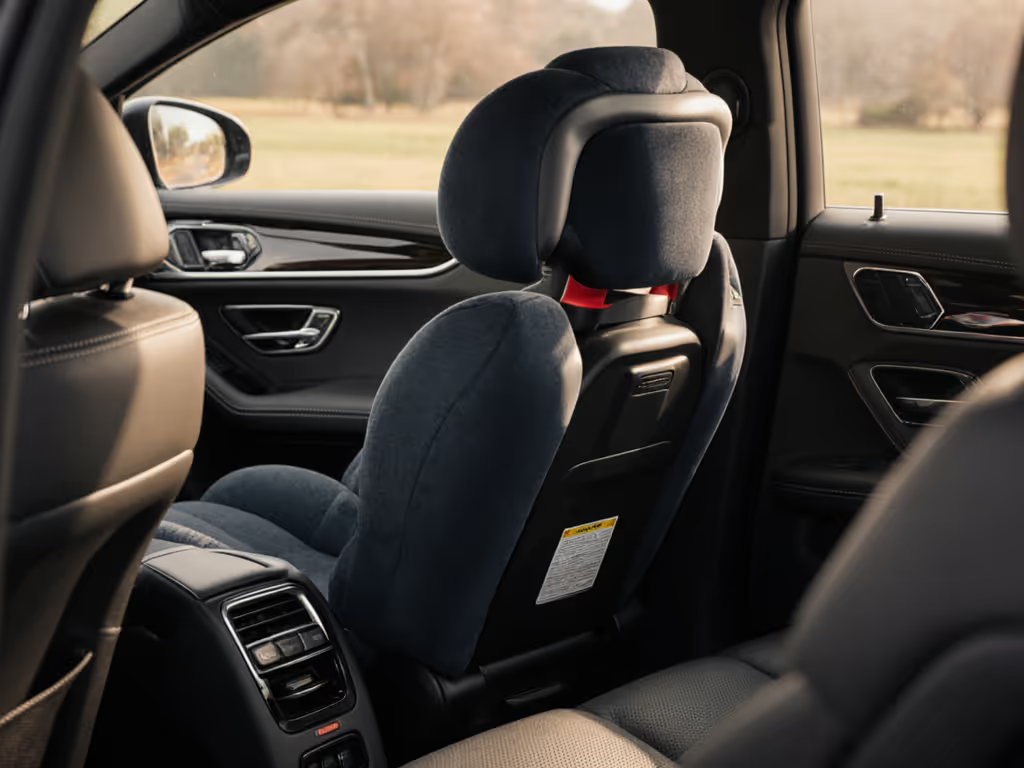
Did you know that proper car seats can reduce the risk of fatal injury by up to 71 percent for infants in car crashes? Parents often face endless options and confusion when picking the right seat for their child’s safety. Understanding convertible car seats can mean fewer purchases, better protection, and peace of mind for years as your child grows.
Key Takeaways
| Point | Details |
|---|---|
| Versatility of Convertible Seats | Convertible car seats adapt from rear-facing to forward-facing, supporting children from birth to about 4-7 years, offering extended protection and value. |
| Safety Innovations | Modern convertible seats feature advanced safety technologies like side-impact protection and sensor monitoring, enhancing child safety during travel. |
| Cost-Effectiveness | Investing in a convertible car seat consolidates multiple seat purchases into one, providing economic benefits and consistent safety throughout various growth stages. |
| Legal Compliance | Proper installation of convertible car seats is legally mandated, highlighting the importance of adhering to safety standards and thorough installation checks. |
Convertible Car Seats Defined and Debunked
A convertible car seat is the Swiss Army knife of child passenger safety gear - a single seat that adapts as your child grows. Unlike single-stage infant carriers, these versatile seats transition seamlessly between rear-facing and forward-facing configurations, providing extended protection through multiple developmental stages.
The core design allows parents to maximize safety and value. Convertible seats typically support children from birth to around 4-7 years old, accommodating weight ranges between 5 to 65 pounds depending on specific model specifications. Their defining feature is the 5-point harness system which securely restrains a child at the shoulders, hips, and between the legs, distributing crash forces more effectively than older restraint designs.
"The American Academy of Pediatrics recommends keeping children rear-facing until they reach the maximum limits of the seat's rear-facing mode"
What makes convertible seats truly remarkable is their commitment to extended rear-facing protection. Modern seats are engineered to keep children rear-facing much longer than previous generations, which significantly reduces injury risks during collisions. This design philosophy prioritizes protecting a child's vulnerable head, neck, and spine during critical developmental years.
- Supports multiple child growth stages
- Offers superior crash protection
- Cost-effective alternative to multiple single-stage seats
- Adjustable configuration for optimal safety
Understanding convertible car seats isn't just about purchasing equipment - it's about making an informed safety investment for your child's most vulnerable years.
Major Types of Convertible Car Seats Explained
When it comes to convertible car seats, parents have several strategic options designed to match different safety needs and developmental stages. These seat types range from basic convertible models to more comprehensive solutions that adapt as your child grows, each with unique features and protection capabilities.
The primary categories include standard convertible seats, combination seats, and all-in-one seats. Standard convertible seats transition from rear-facing to forward-facing modes, typically supporting children from 5 to 65 pounds. These seats provide a straightforward, focused approach to child passenger safety during early childhood stages.
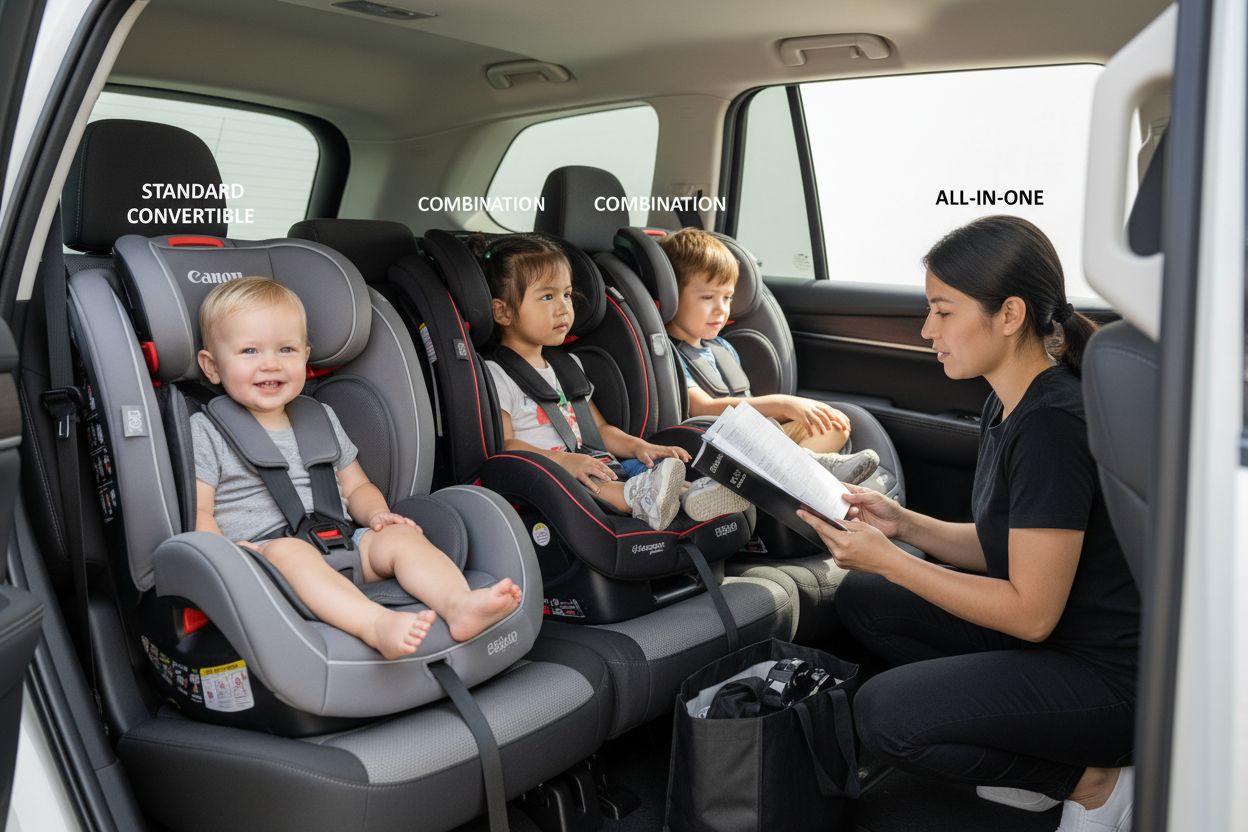
Seat Type Breakdown
Here's a comparison of the main convertible car seat types:
| Seat Type | Child Weight Range | Stages Covered | Key Features |
|---|---|---|---|
| Standard Convertible | 5-65 lbs | Rear-facing<br>Forward-facing | 5-point harness<br>Dual mode |
| Combination | 20-100 lbs | Forward-facing<br>Booster | Harness-to-booster<br>Extended use |
| All-in-One | 5-100+ lbs | Rear-facing<br>Forward-facing<br>Booster | Multiple stages<br>Longest lifespan |
- Standard Convertible Seats: Rear-face to forward-face transition
- Combination Seats: Forward-facing with harness, then convert to booster
- All-in-One Seats: Most comprehensive design, supporting multiple stages
Advanced all-in-one seats represent the Swiss Army knife of child restraint systems. These multi-stage seats support children from birth through booster years, often accommodating weights up to 100 pounds. While more expensive initially, they eliminate the need to purchase multiple seats as your child grows. Combination seats offer a middle ground, starting as forward-facing harness seats before transitioning to belt-positioning boosters.
Safety experts recommend selecting a seat that provides the most extended protection within your budget and vehicle configuration.
Choosing the right convertible car seat isn't just about price - it's about understanding your child's specific safety requirements and selecting a seat that offers maximum protection through critical developmental years.
Key Safety Features and Innovative Designs
Modern convertible car seats are engineering marvels packed with cutting-edge safety technologies designed to protect children in ways previous generations could never imagine. The evolution of car seat design has transformed from simple padded restraints to sophisticated safety systems that actively work to minimize injury risks during potential collisions.
Core Safety Innovations
- Side-Impact Protection Pods: Specialized cushioning that absorbs and disperses crash forces
- Energy-Absorbing Foam: EPS/EPP materials that compress to reduce direct impact energy
- Anti-Rebound Bars: Mechanical devices preventing seat rotation during crashes
- Sensor Technologies: Advanced monitoring systems tracking installation and child positioning
The most groundbreaking developments include sensor-laden designs that can detect and alert parents to critical safety issues. Some advanced seats now incorporate military-grade materials like carbon fiber, providing unprecedented energy absorption capabilities. These smart technologies go beyond passive protection, actively monitoring installation integrity and child positioning to ensure maximum safety.
"Modern car seat technologies transform passive restraints into active safety systems"
Manufacturers are increasingly integrating intelligent safety features like SensorSafe technology, which can alert parents about potentially dangerous situations such as unbuckled harnesses or children left unattended in vehicles.
 These innovations represent a quantum leap in child passenger safety, turning convertible car seats from simple protective shells into sophisticated guardian systems that adapt and respond to real-world challenges.
These innovations represent a quantum leap in child passenger safety, turning convertible car seats from simple protective shells into sophisticated guardian systems that adapt and respond to real-world challenges.
Extended Use and Long-Term Cost Benefits
The financial wisdom of convertible car seats goes far beyond their initial price tag. These versatile safety solutions represent a strategic investment that can potentially save parents hundreds of dollars by eliminating the need for multiple seat purchases as children grow through different developmental stages.
Cost-Saving Breakdown
- Single Seat, Multiple Stages: From infant to booster age
- Potential Lifespan: Up to 8 years of continuous use
- Reduced Replacement Costs: One seat instead of multiple specialized seats
- Extended Rear-Facing Capabilities: Maximum safety, maximum value
Convertible seats are engineered to adapt seamlessly to a child's growth, typically supporting weights from 5 to 65 pounds. This means a single seat can transition from rear-facing infant protection to forward-facing toddler configuration, and in some advanced models, even convert to a booster seat. Parents effectively eliminate multiple equipment purchases, transforming what seems like a higher upfront cost into a long-term financial strategy.
"Investing in a quality convertible car seat is not an expense, but a strategic financial decision for child safety"
Beyond monetary considerations, these seats offer unparalleled safety continuity. By providing consistent protection through multiple growth stages, convertible car seats ensure that children remain securely positioned as their physical dimensions change. The economic benefits are compelling: instead of buying 3-4 separate seats, parents can invest in one high-quality unit that grows alongside their child, delivering both financial efficiency and unwavering safety protection.
Legal Standards and Installation Obligations
Navigating the legal landscape of car seat safety requires understanding complex federal regulations and state-specific mandates that govern child passenger protection. The Federal Motor Vehicle Safety Standard 213 (FMVSS 213) establishes the critical baseline for car seat design, performance, and safety requirements that all manufacturers must meet before bringing a product to market.
Key Legal Requirements
- Minimum Performance Standards: Crash testing and structural integrity
- Weight and Age Guidelines: Mandatory protective configurations
- Labeling Requirements: Clear installation and usage instructions
- Periodic Safety Certification: Ongoing compliance monitoring
Beyond federal standards, installation obligations represent a critical responsibility for parents and caregivers. Proper installation isn't just recommended - it's legally essential. Most jurisdictions require children to be secured in appropriate restraint systems based on age, weight, and developmental stage, with potential fines for non-compliance ranging from $50 to $500 depending on local regulations.
"Proper car seat installation is a legal requirement, not an optional safety suggestion"
Modern convertible car seats come equipped with multiple safety features designed to simplify correct installation. LATCH system (Lower Anchors and Tethers for Children) provides standardized attachment points, reducing installation complexity and minimizing human error. Parents should prioritize professional installation checks or certified technician consultations to ensure full legal compliance and maximum child protection.
Comparing Convertible Seats to Other Options
When it comes to child passenger safety, parents face a complex landscape of seating options, each with unique advantages and limitations. Convertible car seats occupy a strategic middle ground, offering more flexibility than single-stage seats while providing more focused protection than comprehensive all-in-one solutions.
Seat Type Comparison
- Infant-Only Seats: Portable, lightweight, short usage span
- Convertible Seats: Extended use, rear-to-forward conversion
- All-in-One Seats: Maximum stage coverage, highest cost
- Booster Seats: Minimal protection, for older children
Infant-only seats excel in portability, typically featuring detachable carriers that integrate with strollers. However, these seats have a dramatically shorter usage window - often just 12 months. Convertible seats, by contrast, provide a more economical solution, supporting children from 5 to 65 pounds and transitioning seamlessly between rear and forward-facing configurations.
"The right car seat isn't about finding the cheapest option, but selecting the most appropriate protection for your child's developmental stage"
All-in-one seats represent the most comprehensive option, supporting children from birth through booster years. While offering maximum longevity, they come with higher upfront costs and larger physical footprints. Convertible seats strike an optimal balance - providing extended protection, reasonable pricing, and adaptable design without the bulk of full all-in-one systems.
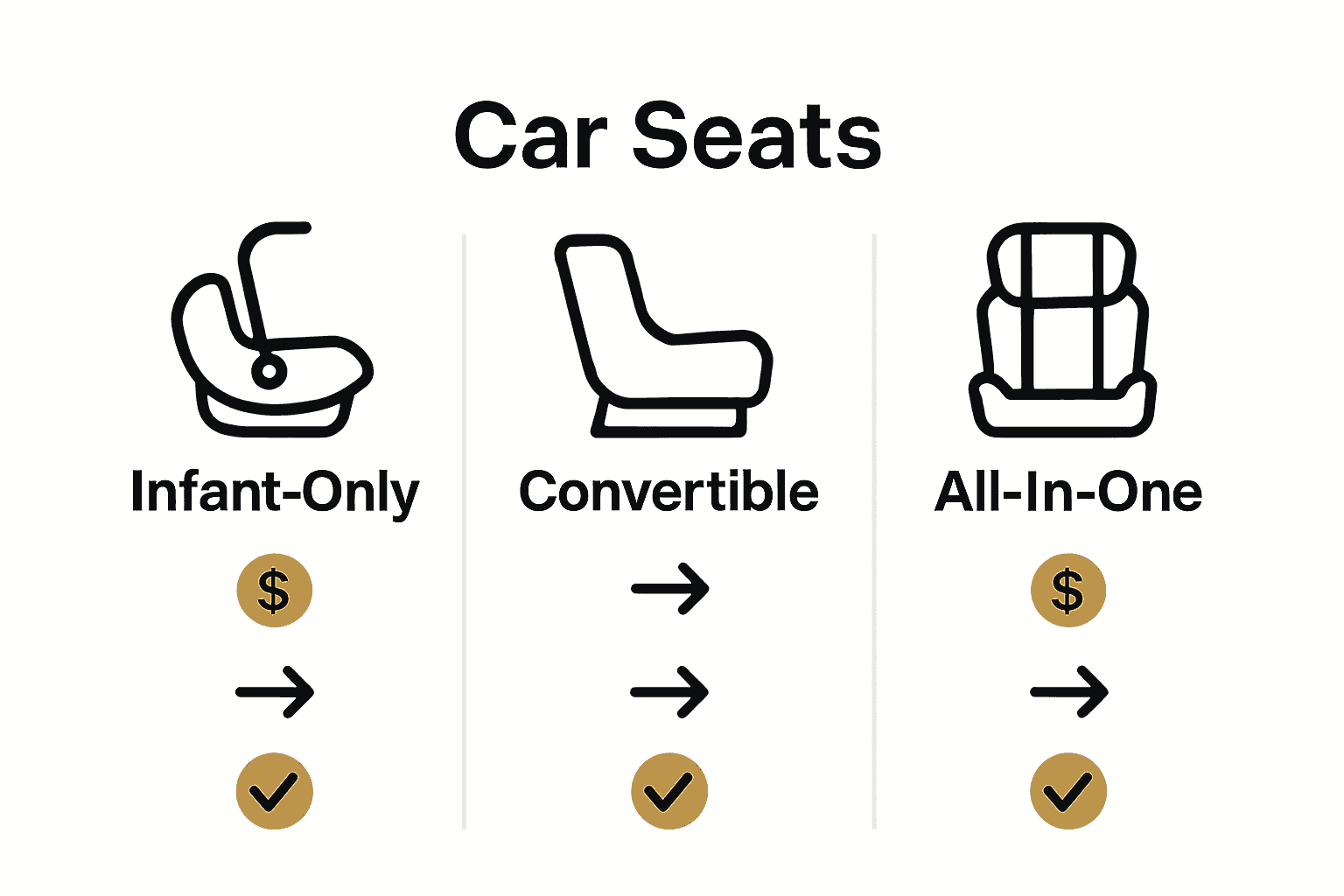 The key is matching the seat's capabilities to your specific family needs and vehicle constraints.
The key is matching the seat's capabilities to your specific family needs and vehicle constraints.
Take the Stress Out of Choosing the Right Convertible Car Seat
Making the best choice for your child's safety can feel overwhelming. This article highlights how confusing it is to compare seat types, keep up with safety standards, and ensure a secure fit as your child grows. Parents worry about cost, proper installation, and finding a seat that truly adapts from infant to toddler years. Practical challenges like navigating FMVSS 213 compliance, harness systems, and everyday comfort are real struggles for families just like yours.
Turn expert advice into confident action today. Visit Fits for Years Seats for:
- In-depth product comparisons based on safety, ease, and longevity
- Research-driven reviews that translate complex science into simple, actionable recommendations
- Personalized guidance for different vehicles, ages, and family needs
Stop second-guessing your child's protection. Get up-to-date, trustworthy guidance now at Fits for Years Seats and start your journey to safer, smarter car seat solutions.
Frequently Asked Questions
What is a convertible car seat?
A convertible car seat is a versatile child safety seat that can transition between rear-facing and forward-facing modes, accommodating children from birth to approximately 4-7 years old.
What are the main types of convertible car seats?
The primary types include standard convertible seats, combination seats, and all-in-one seats, each offering different weight ranges and stages of use.
Why should I choose a convertible car seat over an infant-only seat?
Convertible car seats provide longer usability, adapting as your child grows, while infant-only seats often have a shorter usage window and are less versatile.
What are the key safety features to look for in a convertible car seat?
Look for features such as side-impact protection pods, energy-absorbing foam, anti-rebound bars, and advanced sensor technologies to enhance safety during travel.

